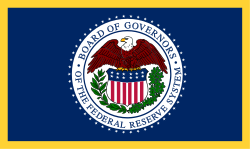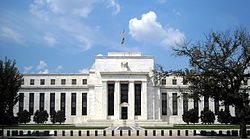
Back نظام الاحتياطي الفدرالي Arabic Sistema de la Reserva Federal AST Federal Ehtiyat Sistemi Azerbaijani فدرال رزرو AZB Федерален резерв Bulgarian ফেডারেল রিজার্ভ Bengali/Bangla Sistema de la Reserva Federal Catalan Federální rezervní systém Czech Y Gronfa Ffederal Welsh USA's centralbank Danish
 Seal of the Federal Reserve System | |
 Flag of the Federal Reserve System | |
 The Eccles Building in Washington, D.C., which serves as the Federal Reserve System's headquarters | |
| Headquarters | Eccles Building, Washington, D.C., U.S. |
|---|---|
| Established | December 23, 1913 |
| Governing body | Board of Governors |
| Key people | |
| Central bank of | United States |
| Currency | United States dollar USD (ISO 4217) |
| Reserve requirements | None[1] |
| Bank rate | 4.50%[2] |
| Interest rate target | 4.25–4.50%[3] |
| Interest on reserves | 4.40%[4] |
| Interest paid on excess reserves? | Yes |
| Website | www |
| Federal Reserve | |
| Agency overview | |
| Jurisdiction | Federal government of the United States |
| Child agency | |
| Key document | |
| This article is part of a series on |
| Banking in the United States |
|---|
The Federal Reserve System (often shortened to the Federal Reserve, or simply the Fed) is the central banking system of the United States. It was created on December 23, 1913, with the enactment of the Federal Reserve Act, after a series of financial panics (particularly the panic of 1907) led to the desire for central control of the monetary system in order to alleviate financial crises.[list 1] Over the years, events such as the Great Depression in the 1930s and the Great Recession during the 2000s have led to the expansion of the roles and responsibilities of the Federal Reserve System.[6][11]
Congress established three key objectives for monetary policy in the Federal Reserve Act: maximizing employment, stabilizing prices, and moderating long-term interest rates.[12] The first two objectives are sometimes referred to as the Federal Reserve's dual mandate.[13] Its duties have expanded over the years, and currently also include supervising and regulating banks, maintaining the stability of the financial system, and providing financial services to depository institutions, the U.S. government, and foreign official institutions.[14] The Fed also conducts research into the economy and provides numerous publications, such as the Beige Book and the FRED database.[15]
The Federal Reserve System is composed of several layers. It is governed by the presidentially-appointed board of governors or Federal Reserve Board (FRB). Twelve regional Federal Reserve Banks, located in cities throughout the nation, regulate and oversee privately owned commercial banks.[16] Nationally chartered commercial banks are required to hold stock in, and can elect some board members of, the Federal Reserve Bank of their region.
The Federal Open Market Committee (FOMC) sets monetary policy by adjusting the target for the federal funds rate, which generally influences market interest rates and, in turn, US economic activity via the monetary transmission mechanism. The FOMC consists of all seven members of the board of governors and the twelve regional Federal Reserve Bank presidents, though only five bank presidents vote at a time—the president of the New York Fed and four others who rotate through one-year voting terms. There are also various advisory councils.[list 2] It has a structure unique among central banks, and is also unusual in that the United States Department of the Treasury, an entity outside of the central bank, prints the currency used.[22]
The federal government sets the salaries of the board's seven governors, and it receives all the system's annual profits after dividends on member banks' capital investments are paid, and an account surplus is maintained. In 2015, the Federal Reserve earned a net income of $100.2 billion and transferred $97.7 billion to the U.S. Treasury,[23] and 2020 earnings were approximately $88.6 billion with remittances to the U.S. Treasury of $86.9 billion.[24] Although an instrument of the U.S. government, the Federal Reserve System considers itself "an independent central bank because its monetary policy decisions do not have to be approved by the president or by anyone else in the executive or legislative branches of government, it does not receive funding appropriated by Congress, and the terms of the members of the board of governors span multiple presidential and congressional terms."[25] The Federal Reserve has been criticized by some for its approach to managing inflation, perceived lack of transparency, and its role in economic downturns.[26][27][28]
- ^ "Reserve Requirements". Federal Reserve System. Retrieved May 10, 2020.
- ^ "The Federal Reserve Bank Discount Window & Payment System Risk Website". Federal Reserve System. Retrieved December 19, 2024.
- ^ "Open Market Operations Archive". Federal Reserve System. Retrieved December 19, 2024.
- ^ "Interest on Required Reserve Balances and Excess Balances". Federal Reserve System. Retrieved December 19, 2024.
- ^ Cite error: The named reference
mnglasswas invoked but never defined (see the help page). - ^ a b Cite error: The named reference
initialwas invoked but never defined (see the help page). - ^ BoG 2005, pp. 1–2
- ^ Cite error: The named reference
FDS-H-04was invoked but never defined (see the help page). - ^ Cite error: The named reference
FDS-H-05was invoked but never defined (see the help page). - ^ Cite error: The named reference
FDS-H-06was invoked but never defined (see the help page). - ^ BoG 2005, pp. 1 "It was founded by Congress in 1913 to provide the nation with a safer, more flexible, and more stable monetary and financial system. Over the years, its role in banking and the economy has expanded."; Patrick, Sue C. (1993). Reform of the Federal Reserve System in the Early 1930s: The Politics of Money and Banking. Garland. ISBN 978-0-8153-0970-3.
- ^ 12 U.S.C. § 225a
- ^ "What is the Federal Reserve's mandate in setting monetary policy?". Federalreserve.gov. January 25, 2012. Archived from the original on January 26, 2012. Retrieved April 30, 2012.
The Congress established two key objectives for monetary policy—maximum employment and stable prices—in the Federal Reserve Act. These objectives are sometimes referred to as the Federal Reserve's dual mandate.
- ^ "FRB: Mission". Federalreserve.gov. November 6, 2009. Retrieved October 29, 2011.
- ^ "What is FRED? | Getting To Know FRED". Retrieved September 16, 2024.
- ^ BoG 2005, pp. v (See structure); "Federal Reserve Districts". Federal Reserve Online. n.d. Archived from the original on February 8, 2012. Retrieved August 29, 2011.; "Federal Reserve Board – Advisory Councils". Board of Governors of the Federal Reserve System. Archived from the original on April 13, 2015.
- ^ "FAQ – Who owns the Federal Reserve?". Federal Reserve website. Retrieved December 1, 2015.
- ^ Lapidos, Juliet (September 19, 2008). "Is the Fed Private or Public?". Slate. Retrieved August 29, 2011.
- ^ Toma, Mark (February 1, 2010). "Federal Reserve System". EH. Net Encyclopedia. Economic History Association. Archived from the original on May 13, 2011. Retrieved February 27, 2011.
- ^ "Federal Reserve System". eh.net.
- ^ "Who owns the Federal Reserve Bank?". FactCheck. March 31, 2008. Retrieved February 26, 2014.
- ^ "Coins and Currency". US Dept of Treasury website. August 24, 2011. Archived from the original on December 3, 2010. Retrieved August 29, 2011.
- ^ "Press Release – Federal Reserve Board announces Reserve Bank income and expense data and transfers to the Treasury for 2015". Board of Governors of the Federal Reserve System. January 11, 2016. Retrieved March 12, 2016.
- ^ "Press Release – Federal Reserve System publishes annual financial statements". www.federalreserve.gov. Board of Governors of the Federal Reserve System. March 22, 2021. Retrieved January 4, 2022.
- ^ "FAQ". Who Owns the Federal Reserve?. Board of Governors of the Federal Reserve System. Retrieved December 1, 2015.
- ^ "Taylor: Federal Reserve Monetary and the Financial Crisis: A Reply to Chairman Ben Bernanke – WSJ". January 27, 2015. Archived from the original on January 27, 2015. Retrieved August 22, 2024.
- ^ "The Latest Fed Criticism? Holding on Too Tight". Bloomberg.com. June 22, 2024. Retrieved August 22, 2024.
- ^ "More Than Half of U.S. Wants Fed Curbed or Abolished – Bloomberg". Bloomberg. May 14, 2022. Archived from the original on May 14, 2022. Retrieved August 22, 2024.
Cite error: There are <ref group=list> tags on this page, but the references will not show without a {{reflist|group=list}} template (see the help page).